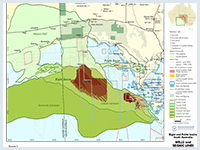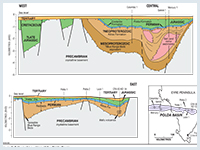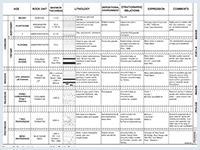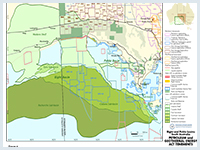On this page
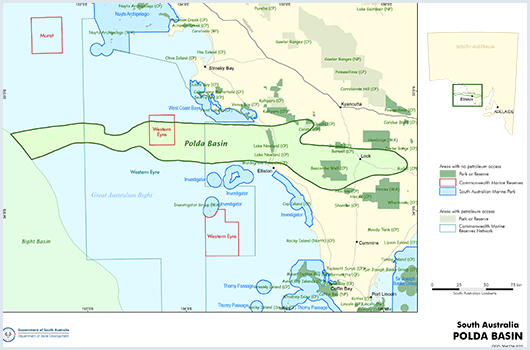 The Polda Basin is a Neoproterozoic - Jurassic basin.
The Polda Basin is a Neoproterozoic - Jurassic basin.
The Polda Basin contains sediments which range in age from Neoproterozoic to Jurassic, overlies the Itiledoo Basin and is overlain by a thin veneer of Tertiary sediments.
Summary
| Age | Neoproterozoic - Jurassic |
|---|---|
| Area in South Australia | 10 000 km2 (3860 sq miles) |
| Depth to target zone | 300-700m |
| Thickness | 300-2000m |
| Hydrocarbon shows | None |
| First commercial discovery | None |
| Identified reserves | Nil |
| Undiscovered resources (50%) | Not determined |
| Production | Nil |
| Basin type | Intracratonic graben or rift valley |
| Depositional setting | Fluvioglacial to fluviolacustrine |
| Reservoirs | Fluvial and lacustrine sandstones |
| Regional structure | Complex dextral wrench faults, diapirs (Neoproterozoic); tensional (Mesozoic) |
| Seals | Intraformational shale or evaporite |
| Source rocks | Non-marine shale, coal |
| Number of wells | 3 offshore, 5 stratigraphic onshore, numerous coal wells onshore |
Seismic line km | 111 2D onshore, 3380 2D offshore |
Prospectivity
The intracratonic Polda Basin is an elongate easterly trending trough that extends for at least 350 km from the Eyre Peninsula to the centre of the Great Australian Bight. It ranges from 10 to 40 km in width and has a water depth that varies from 50 to 200 m at the western end of the basin. The Polda Basin contains sediments which range in age from Neoproterozoic to Jurassic, overlies the Itiledoo Basin and is overlain by a thin veneer of Tertiary sediments.
Petroleum exploration has been mainly confined to the offshore central Polda Basin following the discovery of the basin by the Shell aeromagnetic survey in 1966. Seismic was acquired by Shell and Bridge Oil, who identified drilling targets. Gemini 1 was the first petroleum well drilled in 1975 by Outback Oil, while Mercury 1 and Columbia 1 were drilled by Australian Occidental in 1981–82. There has been no exploration carried out since 1982, with the exception of five seismic lines (totalling 125 km within the Polda Basin) obtained as part of a 1986 survey by the Bureau of Mineral Resources (BMR; now Geoscience Australia) and three seismic lines extending into the basin (104 km within the Polda Basin) shot in 1998 by GHD Surveys Pty Ltd. One PEL has been granted and one onshore application is current over the Polda Trough, the target is coal seam methane and or insitu gasification associated with the Lock Coal Deposit and Polda Formation.
The Neoproterozoic Kilroo Formation is the basal unit of the Polda Basin. The formation consists of siltstone and mudstone with interbedded volcanics, chiefly basalt. Deposition was in an arid, terrestrial fluvial to playa lake environment. Thin layers and veins of anhydrite are common, while massive halite was penetrated in Mercury 1.
The Permo-Carboniferous Coolardie Formation unconformably overlies the Kilroo Formation and consists of diamictite with thin interbeds of siltstone, claystone and conglomerate deposited in a fluvioglacial environment. Thickness of the formation is variable, ranging offshore from 37 m (Gemini 1) to 87 m (Mercury 1).
The overlying Late Jurassic Polda Formation can be subdivided into two intervals. The lower zone is sand-prone with regular interbeds of coal and siltstone, while the upper zone is dominated by claystone, siltstone and fining upward sandstone. The Polda Formation was deposited in a fluviolacustrine environment. The thickness of the formation ranges from 450–500 m in Columbia 1 and Mercury 1, but is highly variable across the basin, since the formation infilled topographic lows.
The Polda Formation has good source potential in the upper Jurassic coals with a mean TOC of 2.56% in Mercury 1. Rock-Eval pyrolysis indicates good genetic potential ranging from 2.97–22.42 kg/t.
Vitrinite reflectance values suggest however, that the currently drilled portions of the basin are immature for hydrocarbon generation and that maturity will only be reached at considerable depth; either on the flanks of the central Polda Basin or to the west, where potential Mesozoic source and reservoir rocks may be present.
Kilroo and Coolardie formations, where drilled to date, are devoid of source rocks.
Reservoir potential is excellent in the porous and permeable Polda Formation. Log derived porosities of up to 19% have been recorded from sandy intervals within the Kilroo Formation. Reservoir sand of variable quality is present in the Coolardie Formation.
Claystone and shale of the Coolardie Formation and intraformational evaporites are potential seals for the Kilroo Formation. However, low apparent source potential downgrades its prospectivity. In the lower zones of the Polda Formation, coal and siltstone could provide an adequate intraformational seal.
Potential plays include unconformity traps at the top of the Kilroo Formation, salt-associated traps, large intra-graben horsts, monoclinal drape features and clastic aprons adjacent to the steep southern boundary fault.
Mercury 1 tested an anticlinal closure above an interpreted halite pillow. Columbia 1 was designed to test a large horst structure in the western sector of the Polda Basin. Gemini 1 was terminated before reaching the target sequence.
There is no estimate of undiscovered resources.
Several National Parks and Wildlife reserves are scattered over the onshore portion of the Polda Basin (South Australia Reserved Land figure). Exploration is not permitted in several of these.
Figure 4 shows the licence status at the time of publication.
Use this link for further information on holders of petroleum tenements in South Australia.
Feitz A. J., Wang L., Rees S. & Carr L., 2022. Feasibility of underground hydrogen storage in a salt cavern in the offshore Polda Basin. In: Czarnota, K. (ed.) Exploring for the Future: Extended Abstracts, Geoscience Australia, Canberra.
Flint RB and Rankin LR, 1991. KIMBA, South Australia, sheet SI53-7. South Australia. Geological Survey. 1:250 000 Series — Explanatory Notes.
Jong JTS, 1991. The source and reservoir potential of the Late Jurassic Polda Formation, Polda Basin, SA. University of Adelaide. National Centre for Petroleum Geology and Geophysics. BSc (Hons) thesis (unpublished).
Nelson RG, Crabb TN and Gerdes RA, 1986. A review of geophysical exploration in the Polda Basin, South Australia. APEA Journal, 26(1):319-333.
O’Brien GW, Paraschivoiu E and Hibburt JE eds, in prep. The petroleum geology of South Australia. Volume 5: Great Australian Bight. South Australia. Department of Primary Industries and Resources. Petroleum Geology of South Australia Series. Use this link to view completed chapters.
Stagg HMJ, Cockshell CD, Willcox JB, Hill, AJ, Needham DJL, Thomas B, O’Brien GW and Hough LP, 1990. Basins of the Great Australian Bight region: geology and petroleum potential. Bureau of Mineral Resources, Geology and Geophysics, Australia. Continental Margins Program Folio, 5. Note: this publication is out of print.
Stagg HMJ, Willcox JB and Needham DJJ, 1992. The Polda Basin — a seismic interpretation of a Proterozoic–Mesozoic rift in the Great Australian Bight. BMR Journal of Australian Geology and Geophysics, 13:1-13.
Thrupp B, 2002. A model for the evolution and petroleum potential of the offshore Polda Trough. University of Adelaide. National Centre for Petroleum Geology and Geophysics. BSc (Hons) thesis (unpublished).


